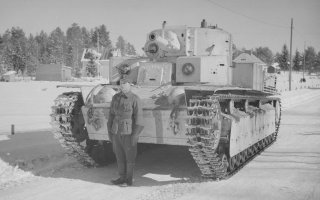Soviet Russia’s Ski Armor Was a Catastrophically Bad Idea
The Soviets were woefully ill-prepared for the Russo-Finnish Winter War.
Here's What You Need to Know: The armored ski sled was just one indicator of a profound failure in Soviet military planning.
It’s no secret that the Soviet army was badly prepared to fight Finnish forces in late 1939 and early 1940, during the brief, bloody and — for the Soviets — catastrophic Russo-Finnish Winter War.
One particularly ill-conceived weapon underscores just how unready the Soviets were. The armored sled. In essence, a pair of overburdened skis supporting an entirely-too-heavy metal shield that Soviet commanders hoped would help protect hapless infantry in the absence of tank and artillery support.
The sled failed. Worse, it actually got a lot of young Soviet troopers needlessly killed.
There’s no shortage of excellent books about the Winter War, which in 105 days between Nov. 30, 1939 and March 12, 1940 claimed the lives of 27,000 Finns and no fewer than 170,000 Soviets. But David Campbell’s new book Finnish Soldier Versus Soviet Soldier — part of Osprey’s “versus” line — does an excellent job explaining just how badly the Finnish army outclassed the Soviet force.
Finland had been part of the Russian Empire until 1917 and, under Joseph Stalin, the Soviet Union wanted Finland back under its control. “Surely the Finns, vulnerable and alone, would do anything to avoid the crushing reality of a war they realistically could not hope to win?” Campbell asks rhetorically.
Stalin ordered his army to attack. The Soviets ran headlong into determined and skilled Finnish defenders who moved swiftly on skis, reindeer-drawn supply trains trailing behind them, specialized forest artillery providing well-timed fire support from the Mannerheim Line, a chain of defenses stretching across Finland near the border with the USSR.
While just 337,000-men strong, the Finnish army was trained and equipped for battle in Finland’s dense, snow-blanketed forests. The 1.6-million-man Soviet army was not similarly trained and equipped.
How could it have been? In 1939, the Soviet army — while big — was a hollow force. Politically-motivated purges starting in 1937 had eliminated many of the Soviet military’s best leaders and brightest innovators. In the aftermath of World War I, Soviet military thinkers had begin to advocate for swift-moving, mechanized, combined-arms warfare. The purges erased that progress.
“By the time of the Winter War the Soviet approach had reverted to the belief that ‘the correct way to win a modern battle was through a slow, methodical advance by masses of foot soldiers, closely supported by artillery, aircraft and tanks that would act as little more than moving shields,’” Campbell writes, quoting historian Mary Habeck.
Problem was, Soviet artillery and tanks in particular weren’t up to the demands of snowbound, winter combat in the woods. The heavy weapons “often could not be brought to bear when and where they were most needed because it was not physically possible to move them through vehicle-heavy divisional columns that had turned into traffic jams kilometers long,” according to Campbell.
The T-26 light tank, for one, “proved to be tactically unsuitable to the terrain of central Finland, with many running out of fuel and ending up as impromptu defensive emplacements dotted up and down the Soviet lines.”
In a desperate — and silly if it weren’t so tragic — attempt to provide the infantry with some kind of protection, the Soviet army distributed armored ski sleds. “Infantry tanks,” it called them.
They didn’t work.
Soviet tank officer Aleksey Shilin witnessed the armored sleds in action during one halting battle. “The command decided to try another attack with the ‘infantry tanks’ that had been rushed out of the factories,” Campbell quotes Shilin recalling in Shilin’s own wartime memoir. “They called it a ‘tank’ because it was made from a panel of 12-millimeter-thick armor, equipped with a firing hole for rifles … and an observation slit for the soldier, so he could watch where he was going.”
“The whole structure was mounted on skis and weighed more than 80 kilograms,” Shilin continued. “Now, just think, the developers quite seriously believed that by equipping our units with these things we would be able to encircle the Mannerheim Line.”
“Of course, life doesn’t work out that way. The skis bearing the ‘infantry tanks’ sank foot-deep in the snow. Many of my friends were killed then. I especially remember one severely wounded soldier, still alive, trying and failing to smother the pain in his face with his hands.”
Rushed reforms eventually improved the Soviet army’s performance and, in March 1940, Finland agreed to peace terms that ceded some territory to the USSR. But it was the Soviet Union’s greater size — and thus deeper reserves — that allowed it to prevail, if the loss of 170,000 people in exchange for small swathes of land can be called “prevailing.”
The armored ski sled was just one indicator of a profound failure in Soviet military planning and leadership in the war with Finland.
David Axe served as Defense Editor of the National Interest. He is the author of the graphic novels War Fix, War Is Boring and Machete Squad.
This article first appeared on WarIsBoring in 2016.
Image: SA-kuva / Wikimedia Commons

